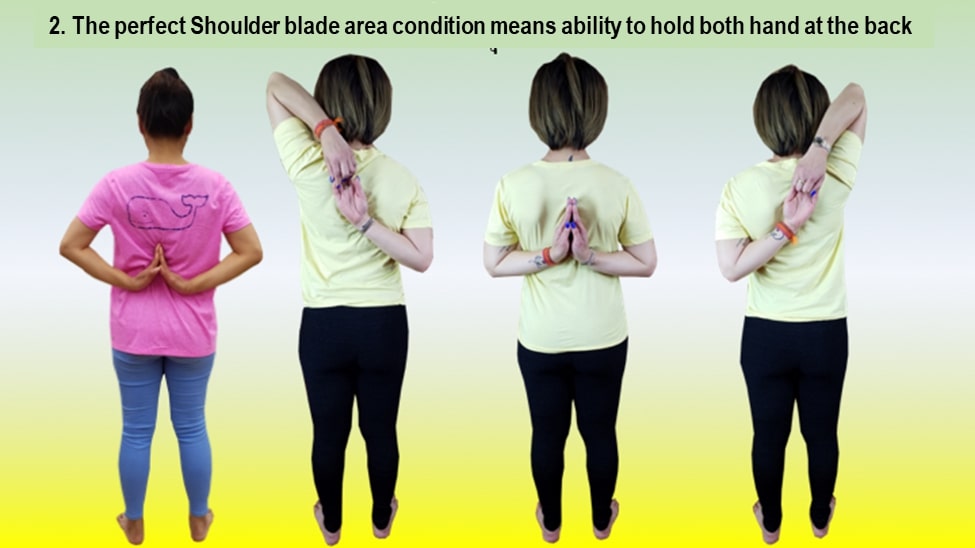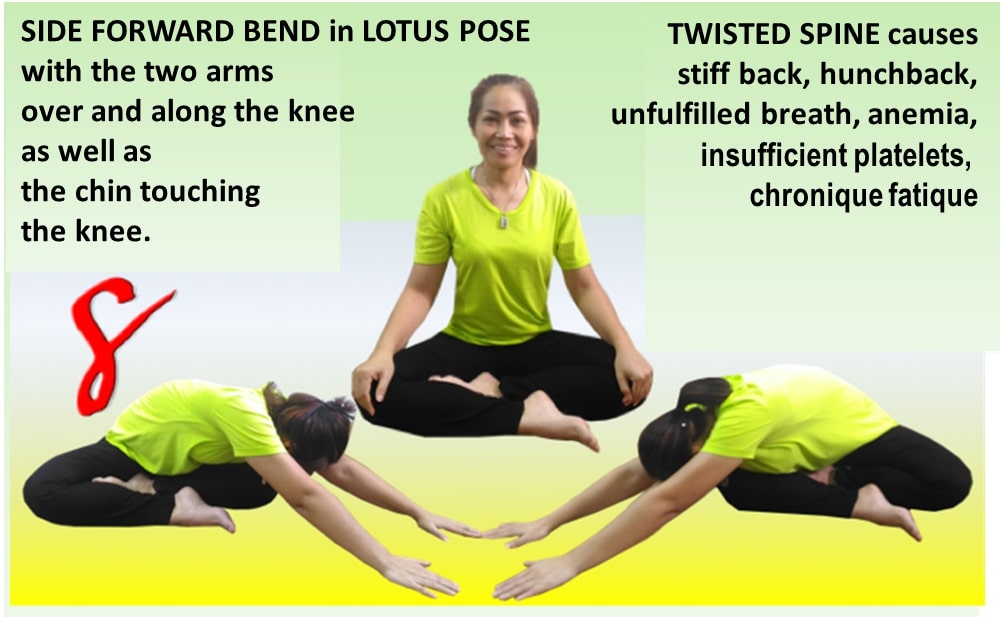Such symptoms as migraine, neck-shoulder-back tension, impingement syndrome, frozen shoulder, tennis elbow, finger lock, herniated disc, sciatic pain, knee pain, heel pain, all of these can be relieved by the proper technic of TSHT.
Firstly, we must do the CHECK UP as follows:
1. ARM RAISE UP POSE
Stand up straight. Feet spread shoulder width. Arms hanging down. Once ready, raise both arms up. An ‘A’ shows abnormal arm raise condition. An ‘B’ shows normal arm raise condition. An ‘C’ shows very good arm raise condition. A healthy person must be able to raise his arms more than 180 degree. If not, we can examine to immediately understand what are the dis-eases: arm arche, twist ligament or stiff tendon, etc … These are the symptom that can be easily solved with TSHT.

This picture demonstrates arm raise dis-ease

2. TRICEP-BICEPBOTH STRETCH ABILITY
For this check up position, the normal muscle flexibility is to be able to have both hands hold together. Or, it means unbalance in the shoulder blade, deltoid, and bicep-tricep areas condition.

If one can practice ‘Sawasdeer’pose at the back, that shows the perfect shoulder blade area condition.

3. HAND TO TOE POSE
Stand up straight. Feet spread shoulder width. Arms hanging down. Once ready, bend body down and let body pending down inch by inch. Observe the level of hands where they can reached. Healthy condition means ability to touch the toe or it is understandable that that person gets back stiffness or pain, kidney dis-ease, stomach discomfort, heart dis-ease, etc …

The healthy person who has the good body circulation and energy flow must be able to bend down and pending down as shown in this picture.

4. SITTING SQUAT POSE
Healthy person must be able to sit squat with both heels touching the floor or one must be at least able to sit squat on the both fist which is on the floor. If one can do so, it shows that one can move or walk without knee pain.

If one is not able to sit as shown in this picture, it shown that one has dis-ease from knee pain, stiff knees, swollen knee or even on is suffering from back pain.

5. SLEEPING DUCK POSE
This is the pose to check the hernia disc condition. One with each of his spine aligned down completely on the floor in sleeping duck pose means excellent condition of hernia disc. One suffered from herniated disc can have his hernia pulled back to normal condition by practicing this pose regularly. When one practice this pose and certain part of his back is not touching the floor, it is possible to assume that he has unbalanced hernia disc or he has a herniated disc syndrome.

If one can do sitting duck pose with both legs lying along the body and he is able to lie down backward, this will help the spine to adjust hernia discs to be back to their own original position.

6. ONE LEGGED HERO POSE
This pose is the check up for the lumbar 4,5 hernia disc condition. If both of the knees touching the floor means the front upper leg muscles are not stiff and the L4,5 hernia disc condition is healthy. But if the knees are lifting in the air means the stiff front upper leg muscles which presents the narrow distance between each disc of L4 and 5. In the future, it can be led into serious herniated disc syndrome.

Please note that no matter either when the right ankle on the above left knee or the left ankle above the right knee, one’s both knees must be touched to the floor. Otherwise, one may feel in the future the serious pain from the hip to leg which the doctor will announce the dis-ease of herniated disc syndrome.

7. VARICOSE
Varicose reveals that some membranes are squeezing the veins or arteries. If the membrane squeezes the veins, the varicose may appear bulging and its color is dark purple or blue. While the fascia squeezing the arteries may look like lean, dry and the skin in that area may be scab. The bulging swollen veins causes the arche shin. These symptoms must be taken care as the blood clot can flow and clog certain part of the body provoking atrophy or paralyzed in the future.

8. SIDE FORWARD BEND in LOTUS POSE
Sitting in single foot lock lotus pose. Bend down forward until both hands touched the floor.
Be careful that your both arms must be over and along the side of the knee. Your chin touches to the knee and both knees touch the floor. One who can either bend to right or left means he has healthy vertebrae spine. He can breathe fully. His body is full of strong red blood cells.
Stiff back, hunchback, twisted spine, discomfort breath are the symptoms of person who has the twisted spine which can be understand by incapability in doing this pose.

9. BUTTERFLY POSE
Unbalance sitting in butterfly pose suggests the impotence, Urinary retention, hemiplegia or paralysis.

10. CERVICAL VERTEBRAE CHECK UP
By turning your face to right with the chin reaching the shoulder,then do the reverse. Notice, if you can do this movement symmetrically: If yes, it means you have healthy cervical vertebrae; If not, it is possible that you have herniated disc syndrome.

